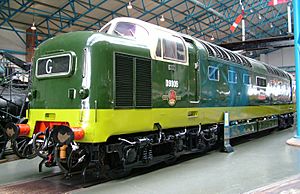British Rail Class 55 facts for kids
Quick facts for kids British Rail Class 55 |
|
 |
|
| D9009 Alycidon at the National Railway Museum, York | |
| Power type | Diesel-electric |
|---|---|
| Builder | English Electric at Vulcan Foundry |
| Build date | 1961–1962 |
| Total production | 22 |
| Configuration | Co-Co |
| UIC classification | Co'Co' |
| Gauge | 4 ft 8 1⁄2 in (1,435 mm) |
| Wheel diameter | 3 ft 9 in (1.143 m) |
| Wheelbase | 58 ft 6 in (17.83 m) |
| Length | 69 ft 6 in (21.18 m) |
| Width | 8 ft 9+1⁄2 in (2.68 m) |
| Height | 12 ft 10 in (3.91 m) |
| Locomotive weight | 99 long tons (101 t) |
| Fuel capacity | 900 imp gal (4,100 L; 1,100 US gal) |
| Prime mover | Napier Deltic D18-25, 2 off |
| Multiple working | Not fitted |
| Top speed | 100 mph (161 km/h) |
| Power output | Engines: 1,650 bhp (1,230 kW) × 2 |
| Tractive effort | Maximum: 50,000 lbf (222 kN) |
| Train heating | Steam generator; later Electric Train Heating |
| Train brakes | Vacuum; later Dual (Air & Vacuum) |
| Career | British Railways |
| Number | D9000–D9021; later 55001–55022 |
| Nicknames | ‘Deltics’ |
| Axle load class | Route availability 5 |
The British Rail Class 55 is a type of powerful diesel locomotive built in the early 1960s. These amazing trains were made by English Electric. They were designed to pull fast passenger trains. They mostly ran on the East Coast Main Line, connecting big cities like London and Edinburgh. People often called them "Deltics" because of their special engines, which were named Napier Deltic. Only 22 of these locomotives were built. They were the kings of the railway until they retired in 1981. Luckily, six of them were saved and can still be seen running today!
Contents
Meet the Deltic Trains!
The Class 55 locomotives were built between 1961 and 1962. They were a brand new type of train for British Rail. Their main job was to carry passengers quickly. They were especially important for the express services. These trains linked London King's Cross to Edinburgh.
The name "Deltic" came from a special engine. The first prototype train was called DP1 Deltic. This prototype train had powerful Napier Deltic engines. These engines gave the Class 55 its famous nickname.
What Made Them Special?
The Deltic locomotives were unique because of their engines. They were diesel-electric trains. This means they used diesel engines to power generators. These generators then made electricity. The electricity powered motors that turned the wheels. Each Deltic had two huge Napier Deltic engines. Each engine produced a lot of power.
These engines made the Deltics very fast. They could reach speeds of up to 100 mph (161 km/h). This speed was very impressive for their time. It helped them become the fastest diesel trains in Britain. Their design was also very distinctive. They had a sleek, powerful look.
Life on the Tracks
The Deltics quickly became famous. They were known for their speed and reliability. They dominated the East Coast Main Line. This was one of Britain's busiest railway lines. They pulled important trains like the Flying Scotsman. They also pulled the Elizabethan and the Talisman.
These trains were a common sight for many years. They carried thousands of passengers. They helped people travel quickly between England and Scotland. They were a symbol of modern railway travel. Many people loved to watch them speed by.
The End of an Era (and a New Beginning!)
By the late 1970s, newer trains were being developed. These new trains were more fuel-efficient. They were also cheaper to maintain. So, the Deltic locomotives began to be retired. Their last regular service was at the end of 1981. It was a sad day for many train fans.
Out of the 22 Deltics built, six were saved. These preserved trains are now looked after by special groups. They are often seen at heritage railways. They also sometimes run on the main railway lines. This lets new generations see these amazing machines. They are a reminder of a golden age of British railways.
Images for kids
-
A line of seven withdrawn Deltics at Doncaster Works in August 1982
-
55 022 Royal Scots Grey at the Barrow Hill Engine Shed
-
55 022 Royal Scots Grey at Linlithgow, after a railtour, on 7 December 2007
-
All six preserved Deltics at Barrow Hill Engine Shed
















